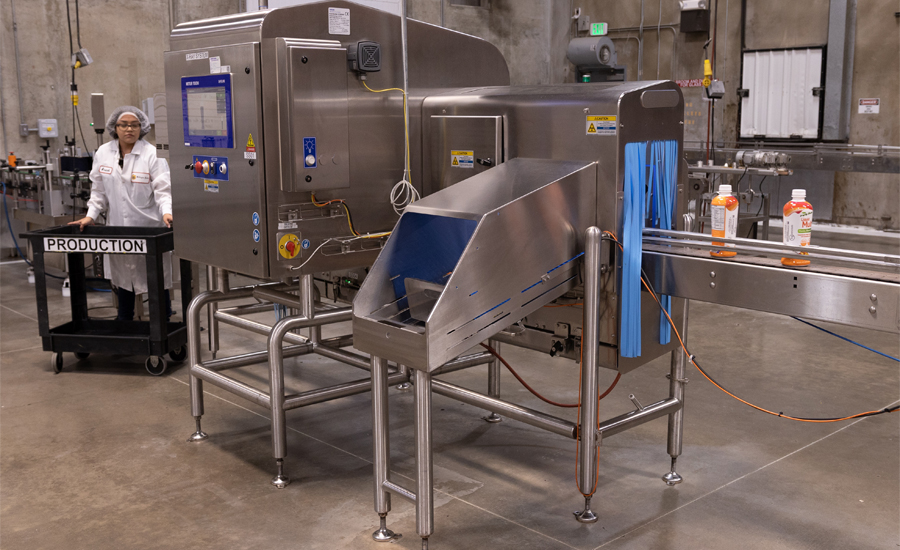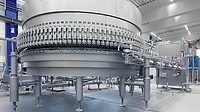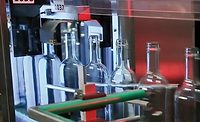Correct inspection equipment necessary to ensure consumer safety
Changes in the industry call for the updated equipment

Image courtesy of Mettler-Toledo
In Pixar’s 2015 movie “Inside Out,” 11-year-old Riley’s five emotions — Joy, Anger, Disgust, Sadness and Fear — work together as Riley adjusts to life in a new city. When Riley creates memories, it is important for the emotions not to touch or tamper with the memory as it is stored in Riley’s head. Interfering with the memories that Riley has made, especially core memories, can impact her moods and overall personality.
Although emotions are not involved in the process, in the beverage industry, it is important for manufacturers to assure consumers that the products they consume are safe and protected. This is done with the help of packaging inspection equipment.
Mark Bussard, product line manager at North Falmouth, MA-based Teledyne TapTone, shares how food safety measures have impacted inspection equipment.
“Equipment performance (tighter specifications) have resulted in the need for design improvements,” he says. “Data logging and connections to central historians for traceability has become a regular requirement, including adding these capabilities to old, pre-existing equipment.”
Experts at Mettler-Toledo, Lutz, FL, convey their insights regarding influence.
Keri Klein, product line manager of checkweighing at Mettler-Toledo, says that, as the FDA finalizes more rules within the Food Safety and Modernization Act (FSMA), product inspection equipment must follow suit and evolve as well. She feels that the industry has a shared responsibility within the global supply chain to help prevent contamination.
“In biological contamination, innovations for enhanced cleanability and sanitization have shaped our wash-down designs, such as not having any flat surfaces, offering tool-less disassembly to allow for easier and more frequent cleaning, as well as a focus on chemical resistance,” Klein explains.
Geri Foley, product line manager of X-ray inspection at Mettler-Toledo, says that, in physical contamination, machinery detects and rejects contaminated product while ensuring that only authorized individuals have access to the machinery. The company provides equipment with such abilities, such as reject door lock access.
Jordan Davis, product line manager of metal detection at Mettler-Toledo, says that Hazard Analysis and Critical Control Points (HACCP) has been pivotal in preventing contamination from reaching the public.
“While inspection systems have been in place in many companies for many years, the way in which they have been implemented, verified and maintained in the past was both varied and sometimes ineffective,” he says. “Food safety measures now give better guidance and control to lower risk, remove more contamination, protect both the brand and the customer, and ensure standards are met and maintained longer-term.”
Teledyne’s Bussard goes into what beverage trends have impacted inspection equipment.
“The packaging material types have broadened as more beverages move from traditional style containers to higher production capabilities and lower cost, as well as eco-friendly type materials,” he says. “[An] example in years past, single-serve wine was never made available in aluminum cans or paper board cartons. This is driving the need for inspection solutions that were never required in the past.”
Mettler-Toledo’s Klein notices a trend in the segment that is investing in vision inspection.
“Producers are looking beyond traditional contamination inspection with metal detectors and/or X-ray systems and [are] searching for solutions to perform more advanced checks, such as bottle integrity (no cracks or dents) and stricter label inspection (no tears or wrinkles),” she says. “‘3R’: Right product in the right package with the right information.”
Klein adds that consumers are holding products to a higher standard, which means manufacturers must help beverage-makers exceed that standard.
Mettler-Toledo’s Davis says that the beverage industry has dramatically changed over the years in many ways.
“Raw materials, including packaging, are now purchased on a global scale and from many more different sources and should be tested before they go into the process,” he states. “Consumer demand has grown, which has created the need for faster, more productive line speeds. Regulatory demands have put more restrictions on the suppliers. Inspection equipment now must have fail safes in place to ensure contamination is not only detected, but also rejected and cannot reach the customer.”
Davis explains that failsafe systems, including reject check, reject confirmation, air failure and bin-full, will alarm and stop the process should there be a failure that would have previously allowed the contaminated product to pass through, even though it was detected.
“It also needs to keep up with higher production speeds while ensuring the same sensitivity requirements and have more compliance features that verify the quality standards are maintained,” Davis says.

Present inspection equipment
As for what types of inspection technology is available to beverage-makers, Mettler-Toledo’s Davis notices an array of metal detection that is used in the beverage industry.
“These include throat and gravity fall detectors, which are more commonly found earlier in the process to remove contamination before it gets to the final product,” he says. “Conveyorized metal detectors are used to look for contamination in the packaging/bottles that may have come from suppliers. For the final product itself, there are pipeline systems that can be implemented before the filling process.”
Davis notes that conveyorized metal detectors can be used for both primary and secondary packed products.
Mettler-Toledo’s Klein, meanwhile, feels that checkweighers placed directly after the filler are a “smart investment for added process control,” because they offer automatic feedback to the filler and adjustment to fill heads to reduce over or under filling. She adds that checkweighers are offered in combination systems to include a vision system, metal detector, and/or an X-ray system, which are offered up to 4-in-1 helping to save floor space.
Mettler-Toledo’s Foley states that X-ray inspection systems perform contamination detection on a variety of materials, such as glass, metal, high-density plastics and rubber. She lists that X-ray inspection systems simultaneously perform product integrity checks like the following:
- Inspect fill levels and measure head space
- Detect missing closures on plastic containers
- Reject damaged packaging
- Detect agglomerates
In terms of what benefits such inspection equipment offers, Mettler-Toledo’s Davis notes that metal detection benefits are linked to the risk assessment performed to determine the HACCP in place.
“Testing at the raw material and pre-packaging stage can remove contaminants early, reducing the amount of product and packaging waste,” he explains. “Testing at the primary packaging stage again can save on retesting or product waste that could be incurred at testing at the secondary or case packed stage.”
Davis adds that modern metal detectors also have features and benefits that can aid sensitivity, improve productivity and aid compliance.
“An X-ray inspection system is able to inspect the fill level and measure head space of each container, which will minimize product waste, which ensures product freshness and, therefore, increases profitability,” Mettler-Toledo’s Foley says. “In addition, an X-ray machine can reliably inspect the presence of caps or lids on plastic containers, ensuring the product is sterile, fresh and without any spillages.”
Teledyne’s Bussard says that there is a wide range of inspection solutions in the beverage industry.
“This can be up stream before filling to inspect empty containers for foreign bodies using vision solutions, all the way to the case packer scanning bar codes as they enter the case,” he observes. “Here at TapTone, we focus primarily on the post-fill and seal area of the production. In this area, we use a variety of technologies to inspect for leaks and verify fill levels.”
Bussard explains that some technologies include proximity sensors, acoustic sensors, load cells, lasers and X-ray. He notes that the company uses optical sensors for detection of missing caps or closures not properly applied.
“Many of the technologies we incorporate have high precision, high reliability and low maintenance,” Bussard says. “Most of our solutions are using technology that has been proven successful for more than 50 years in the food and beverage industry. While we are always improving our software algorithms to be more efficient or take advantage of newer technology, we always look to ensure they achieve the maximum reliability, accuracy and ease of use.”
He also shares factors that beverage operations should take into account when selecting inspection equipment.
“Will it meet your needs now and in the future as the product changes over time, like package size, shape, construction type, production speeds, etc.?” Bussard asks. “In other words, can it grow with you as your business changes? Can it be adapted and expanded to cover all applications for the future?”
Bussard adds that company support and proven history of providing spare parts, technical support and ease of use are other important aspects.
“We know the industry operator turnover can be high, and systems, which are overly complex to operate require extensive training, and this becomes a weak point in any production operations,” he says.
Mettler-Toledo’s Klein shares her thoughts on how beverage-makers should select inspection equipment.
“Beverage manufacturing requires advanced solutions that can run at high speeds while maintaining high precision weighing and prevention of physical contamination in challenging environments,” she says. “Invest in proven equipment suppliers with expertise in product inspection, including proper rejection of product, as well as advanced material handling.”
Davis recommends that beverage-makers partner with a company that will provide systems that deliver brand protection and regulatory compliance, while also offering the services and support needed.
Mettler-Toledo’s Foley notes how uniquely shaped packages have impacted inspection equipment.
“Mettler-Toledo’s auto set-up of each product is very simple and, with enough product presented to an X-ray inspection system, it can learn the bottles’ inconsistencies and reduce false rejects,” she explains. “It is important to realize that there is a balance between the sensitivity that can be achieved versus learning the inclusions in the bottles.”
Teledyne’s Bussard says that uniquely shaped packages have continued to majorly impact inspection equipment design, noting how new container shapes and features can make the product impossible to inspect.
“We believe every new container design should go through an intensive investigation of how it will be inspected at every point in the production process to see if it will be compatible with existing inspection equipment,” he shares. “Often, we find this has not been considered and the product is far down the path of getting to market before the question is asked, ‘Can this design be inspected?’”
In terms of artificial intelligence (AI) and inspection equipment, Bussard feels that it is too soon to speculate. He says that experts can “already envision inspection algorithms that are self-learning and potentially self-optimizing.”
“AI is a powerful tool and we are sure it will play a big role in the future of all inspection equipment solutions,” Bussard adds.
Mettler-Toledo’s Foley says that the company always is exploring leading edge technology like AI.
“Today, we use robots and cobots in our manufacturing process, which allows us to provide a higher quality product at much-reduced lead times,” she notes. “We will continue to incorporate AI into our manufacturing and software developments.”
Looking for a reprint of this article?
From high-res PDFs to custom plaques, order your copy today!






